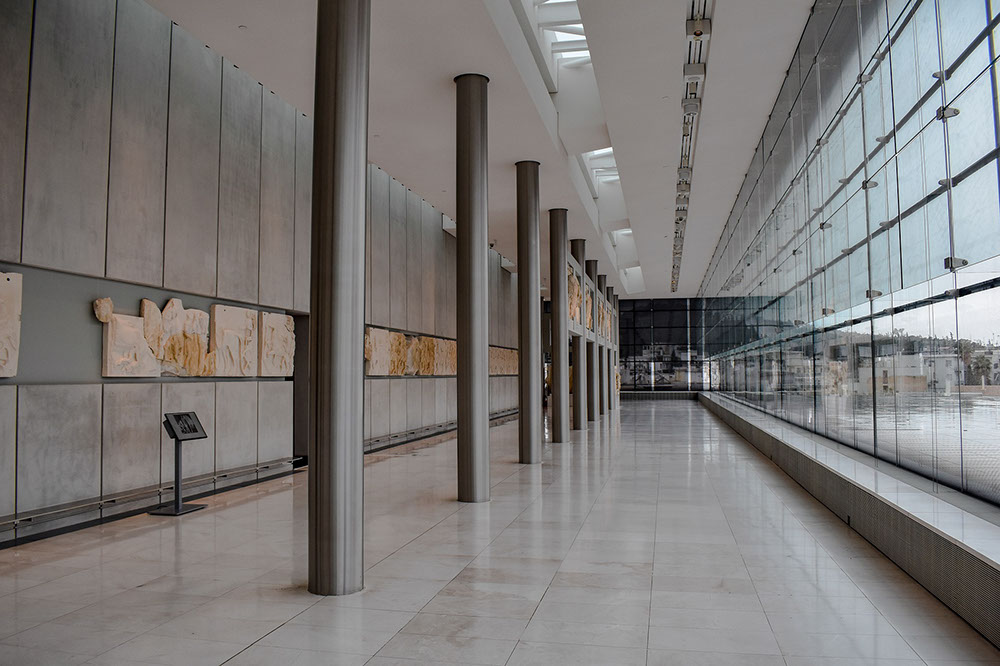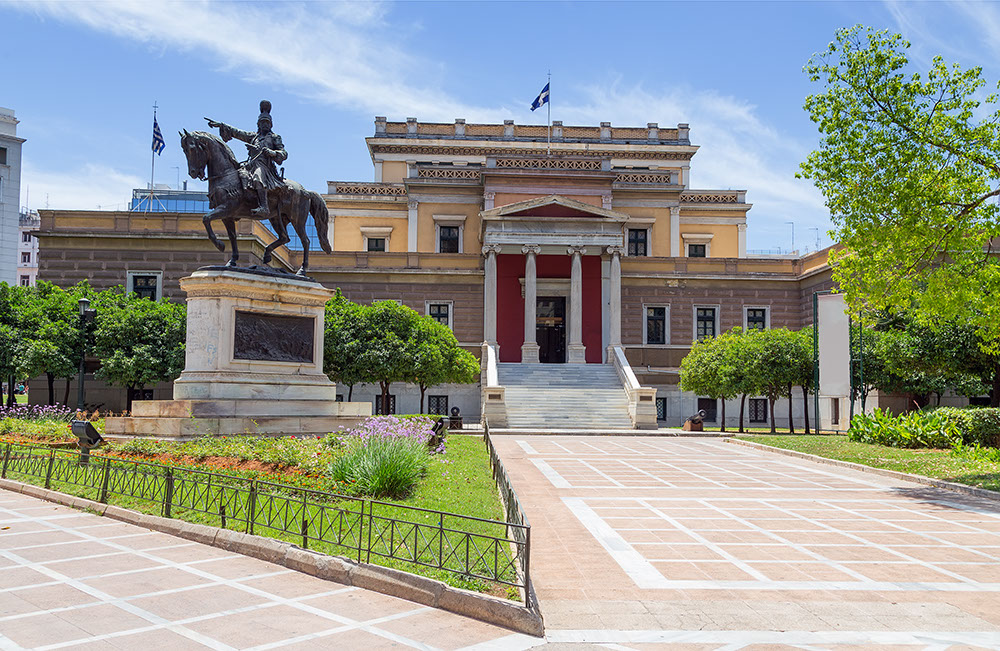A unique cultural journey through the best museums of Athens.
In Athens, a city of great history and culture, which is constantly evolving and building the dynamic profile of a modern European metropolis, its vast cultural heritage is wonderfully displayed in its exceptional museums. Modern oases of culture, each of the museums of Athens, are transformed into an attraction for all residents and visitors of the Greek capital and reveal that modern Athens is an attractive destination of global museum interest, ready to offer great thrills.
Museum of Acropolis.
Just opposite the sacred rock of the Acropolis, at the junction of the pedestrian streets of Dionysiou Areopagitou and Makrigianni, in the historic center of Athens, is the New Acropolis Museum, the most famous museum in Athens and one of the leading museums in the world. The new Acropolis Museum, which replaced the one at the top of the sacred rock, was inaugurated in 2009 and is a masterpiece of modern architecture, with its impressive crystalline appearance, which miraculously exploits the abundant light of Athens, while facilitating visual contact with the top monuments of the rock. The exhibition program of the new Acropolis Museum includes, mainly, five collections with findings from the slopes of the sacred rock, of the archaic, classical and Roman period. Apart from the five original Caryatids of the Erechtheion, which are exhibited on a small balcony, on the second level, everyone's attention is focused on the top floor, which, dedicated entirely to the Parthenon and its sculptural decoration, includes a rectangular glass room, which has the same dimensions and orientation as the magnificent monument. Original pieces, but also copies of the famous sculptures from the pediments, metopes and frieze of the temple, are presented in a masterful way, as if we were inside the monument itself, revealing, once again, that in the case of the Parthenon, the arts and Greek culture reached its peak, turning the Parthenon into an ecumenical cultural symbol. On the second level, a short stop in the cafe-restaurant of the museum, with the amazing view to the Acropolis, will compensate for the senses, offering an experience that will be unforgettable for everyone.

National Archaeological Museum.
The National Archaeological Museum of Athens is the largest museum in Greece and one of the most important museums in the world. With the initial destination to accept all the findings from excavations of the 19th century, mainly from Attica, it gradually acquired the form of a central National Archaeological Museum and was enriched with findings from all over the Greek world. The rich collections, which list more than 11,000 exhibits, offer each visitor a unique panorama of Ancient Greek culture, from the beginning of prehistory to late antiquity.The world-famous Cycladic figurines, of the abstract mentality, the Mycenaean golden mask of King Agamemnon and the famous Linear B plates from Pylos, as well as the amazing geometric amphora of Dipylos, along with the exceptional collection of kouros and statue of Zeus-Poseidon and the little jockey rider of the Hellenistic era, among other masterpieces of Greek art, testify to the artistic intellect of the ancient Greeks and shock the senses.

Old Parliament. National and Historical Museum of Athens.
The National Historical Museum of Athens, one of the most beautiful and comprehensive museums in Greek history, is located on Stadiou Street, in Kolokotroni Square. The imposing neoclassical building was built in 1834 to be the residence of a wealthy Athenian merchant. The Greek government, which had only just been established as an institution, bought the mansion in 1837 to serve as the official residence of the royal couple Otto Amalias, while later, the building was the location of Parliament and the first location of the Greek parliament, which justifies the nickname of the building as the Old Parliament. From the ‘60s onwards, the building was transformed into the National Historical Museum of Athens, an important place of historical memory, but also a suitable roof for important events of cultural and historical content. Through great exhibits in the 13 rooms of the museum, the historical course of modern Hellenism is presented, in chronological order, from the Fall of Constantinople in 1453 to the Greek-Italian war of 1940 and the preservation and projection of the relics, as an integral part of Greek history is achieved.
Benaki Museum.
At the junction of Vasilissis Sofias and Koumbari avenues, in the center of Athens and at the foot of Kolonaki, is the Benaki Museum, one of the most interesting museums in the Greek capital. The building, which was the residence of the merchant Antonis Benakis, after his arrival in Athens from Cairo, Egypt in 1910, was properly landscaped to house the huge collection of works of art from different periods, by its owner and to acquire its innovative museum character. building, which makes it extremely popular to this day.The expansion of its exhibition spaces continued, successfully, in the following years, with the result that the building - museum hosts, among others, relics of important political figures and the famous private collections of rich Athenians, such as the collection of Kyriazi, Eleni Stathatou and others. The large extension between 1989 - 1997, in the northern part of the building, resulted in the addition of a new wing of five floors, with impressive exhibitions of Greek collections, reaching 40,000 works and presenting the Greek world from antiquity to 1922.

Museum of Cycladic Art.
The elegant neoclassical building on Queen Sophia and Herodotus Avenue is one of the important works of the architect Ernest Ziller. The building was the residence of the bourgeois family of Otto and Athena Stathatos, until 1938. In the magnificent mansion, Greek and Roman architectural elements were combined in the decoration of its exterior, while the stepped entrance of Renaissance style and the two-storey arched roof are particularly impressive. The plaster decorations, the chandeliers and the fireplaces of its interior decoration are preserved to this day. The building was purchased by the Hellenic Public Company in 1982, was magnificently renovated and was the second wing of the Museum of Cycladic Art - N.P. Foundation. Goulandris. It houses permanent collections with about 3,000 objects of Cycladic, ancient Greek and Cypriot art, which impress every visitor with their artistic perfection and aesthetics.
War Museum.
It is an impressive modern building, surrounded by a large garden and many trees, at the junction of Vasilissis Sofias and Rizari avenues. In the courtyard of the War Museum, which was inaugurated in 1975 and is the most beautiful example of architectural modernism in all of Athens, various jets of the Air Force and tanks of the Greek army are exhibited, while in the numerous rooms inside, exhibits are presented. , weapons and military uniforms, banners and military manuscripts and documents, which unfold the most important and glorious moments of Greek history, through the military achievements of the Greeks over the centuries. A wonderful open space in the center of the museum, offered for moments of relaxation and recreation, in a museum, which is a living document of the varied Greek history.

Byzantine and Christian museum.
The Byzantine and Christian Museum of Athens is located on Vasilissis Sofias Avenue and next to the War Museum. It is housed in an impressive building, in the famous villa Ilisia, which belonged to the Duchess of Placentia, the French philhellene Sophie de Marbois Lebrun ducesse de Plaisance. It was built in the period 1840-1848, as a winter residence of the Duchess and is of Florentine style. When it was built, under the supervision of the famous architect Stamatis Cleanthis, the house was elevated and had a view of the valley of the river Ilissos. After the death of the Duchess, it was transformed into the Byzantine museum, presenting, since then, the art and architecture of the Christian religion, from Early Christian years, (4th AD), until the middle of the 19th century. The expansion and renovation of the museum was recently completed, which still excites every visitor.















